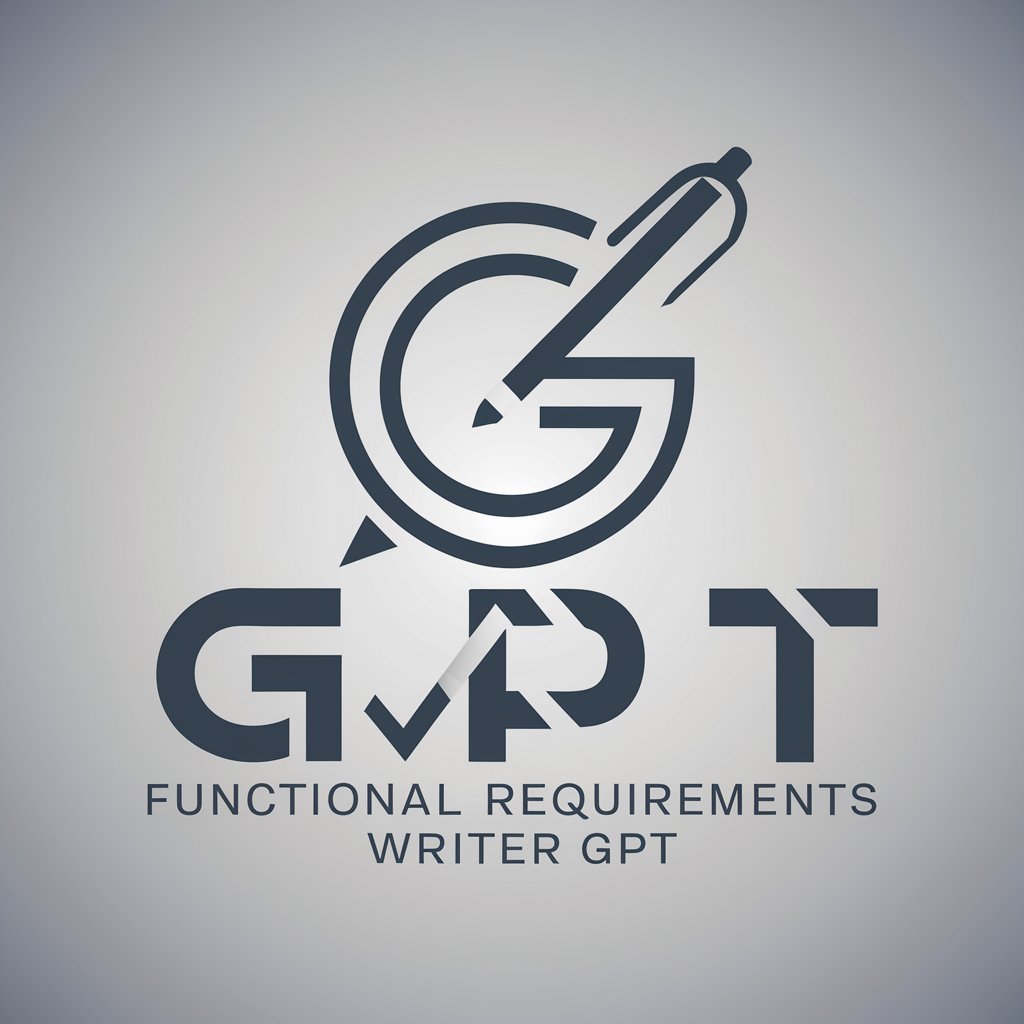Functional Requirements Writer - AI-powered Requirements Crafting

Welcome! Let's craft precise and clear software requirements.
Simplifying software requirements with AI
As a Functional Requirements Writer, describe how...
Define the steps necessary for...
Explain the process of creating...
List the key components of...
Get Embed Code
Overview of Functional Requirements Writer
The Functional Requirements Writer is designed to craft precise and clear functional software requirements, utilizing the Easy Approach to Requirements Syntax (EARS). This method enables the creation of well-defined requirements that are essential for developing software that meets user needs effectively. The approach is structured around five key requirement archetypes: Ubiquitous, State-driven, Event-driven, Optional Feature, and Unwanted Behavior, each tailored to address specific aspects of software functionality. For instance, Ubiquitous requirements describe features that are always applicable; State-driven requirements specify conditions under which certain functionalities are enabled; Event-driven requirements detail the system's response to particular events; Optional features describe functionalities that can be toggled on or off; and Unwanted Behavior requirements outline behaviors the system should avoid. By combining these archetypes, complex requirements can be thoroughly articulated, ensuring software development projects are guided by clear, concise, and comprehensive specifications. Powered by ChatGPT-4o。

Core Functions of the Functional Requirements Writer
Crafting Clear and Concise Requirements
Example
For a project developing a mobile banking app, a requirement might be stated as: 'Upon user authentication, the system shall display the account balance within 5 seconds.'
Scenario
This is crucial in ensuring that the development team understands exactly what needs to be built, reducing ambiguities and the potential for rework.
Utilizing EARS to Address Various Specification Needs
Example
For an e-commerce platform, an Event-driven requirement could be: 'When a customer adds an item to their cart, the system shall update the cart total instantly.'
Scenario
This helps in specifying the system's behavior in response to specific events, making the requirements actionable and testable.
Identifying and Describing Unwanted Behaviors
Example
In a cybersecurity application, an Unwanted Behavior requirement might be: 'The system shall not allow the submission of forms with SQL injection patterns.'
Scenario
This is essential for ensuring the software is resilient against specific types of attacks or failures, enhancing its security and reliability.
Ideal Users of Functional Requirements Writer Services
Software Development Teams
Teams that are in the initial stages of a software project and need to define clear, detailed functional requirements to guide development efforts. These users benefit from the precision and clarity of requirements, ensuring all team members have a shared understanding of what needs to be built.
Product Managers
Product managers who are responsible for defining the vision and scope of a software product. They require a methodical approach to translate high-level business objectives into detailed functional requirements that can be easily understood by the development team.
Quality Assurance Professionals
Quality assurance professionals who need detailed functional specifications to create effective test plans. The clear articulation of requirements helps in identifying test cases that ensure the software functions as intended under various conditions.

Guidelines for Using Functional Requirements Writer
Step 1
Begin by visiting yeschat.ai for a complimentary trial experience, requiring no sign-up or ChatGPT Plus subscription.
Step 2
Identify and clearly define the software project or feature for which you need to write requirements. This will serve as the foundation for generating precise functional requirements.
Step 3
Choose the requirement archetype that best fits your need: Ubiquitous, State-driven, Event-driven, Optional Feature, or Unwanted Behavior. Understanding these archetypes is crucial for accurately specifying your requirements.
Step 4
Use the provided template to input your specific requirement details. Be precise and concise, ensuring clarity and avoiding ambiguity.
Step 5
Submit your requirement details, and the Functional Requirements Writer will generate a structured, well-defined requirement. Review and refine as necessary to ensure it fully captures your intent.
Try other advanced and practical GPTs
Product Requirements Document (PRD) Writer
Streamline product planning with AI.

Confluence Product Requirement Creator
Crafting Clarity in Product Planning

Screening EIA Requirement in Malaysia
Streamline Your EIA Process with AI

ESRS 1 General requirements (CSRD)
Streamlining Sustainability Reporting

SAWIS Labelling Requirement Checker
Ensuring wine label integrity with AI

SAP O2C - Requirements Agent
Streamlining O2C with AI-Powered Insights

Tax Assistant
AI-Powered Tax Filing Simplified

Tax attorney
AI-Powered Tax and Legal Advice

Tax Advisor
AI-Powered Tax Insights

Tax Bachao
AI-powered tax planning for India

Tax Sage
Navigating Tax with AI Expertise

Abrams Tax
Your AI-powered tax law assistant

Frequently Asked Questions about Functional Requirements Writer
What is the Functional Requirements Writer?
The Functional Requirements Writer is an AI-powered tool designed to help users craft precise and well-structured functional requirements for software projects, employing the Easy Approach to Requirements Syntax (EARS) method.
Can I use this tool for any software project?
Yes, the Functional Requirements Writer is versatile and can be used for a wide range of software projects, from small applications to large-scale systems, by selecting the appropriate requirement archetype.
How does the EARS method improve requirement writing?
The EARS method simplifies requirement writing by providing clear templates for different types of requirements. This helps in reducing ambiguity, improving clarity, and ensuring that requirements are directly actionable.
Can I modify the generated requirements?
Absolutely, the generated requirements serve as a starting point. You are encouraged to review and refine the output to perfectly align with your project's specific needs and context.
Are there any prerequisites for using this tool effectively?
The main prerequisite is a clear understanding of your software project's goals and the specific functionalities you wish to define. Familiarity with the types of requirement archetypes used by the EARS method is also beneficial.
